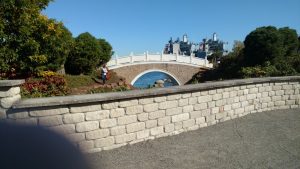
“Those who sacrifice freedom for security deserve neither.” ~Benjamin Franklin
Now that it is week 2, we are starting to get into the nitty-gritty of our studies.
The most impressionable thing to happen this week was definitely our trip to the two museums and Chinese Reconciliation Park. To be honest, I didn’t expect to find much of Asian-American influence on Washington; in fact, I thought the first museum we went to would have a small section in a corner dedicated to their impact. I’m glad to find that this was not the case.
A majority of the countries mentioned in the museum, just like the first book we had to read, was China and Japan. While there were small mentions of the Philippines and India here and there, China and Japan was definitely a major focus.
When it came to Japan, as expected, a majority of the things I read related to World War II. I liked how the museum acknowledged the conspiracy theories surrounding the bombings of Hiroshima and Nagasaki, going in-depth of Japan’s surrender prior to the action taken. For example, it described how people have speculated that this was to test the bombs and/or assert their dominance to the Soviet Union. When I was in high school, I wrote a paper about the latter, so seeing it finally acknowledged felt like a breath of fresh air, since I had always seen the basic set-up of “Japan surrendered after the bombings,” and nothing more.
I also liked how there was one section dedicated to describing Takuichi Fujii’s art and diary, rather than having it mixed with a whole bunch of other art. While he was an issei, like everyone else, he had no intent on returning to Japan, but also makes no declaration of loyalty to America, thus he stayed in an internment camp for around 3 years. During this time, he made so many beautiful oil canvases and drawings, many of which were the buildings and his surroundings. With this art, he created his own personal diary, which did not become discovered until one of his grandchildren decided to display it.
When it comes to WWII, one fact I found really interesting was how this war allowed more African-Americans and women to gain jobs in Washington. They found jobs in the defense industry, since white men were going out to war. “They had to hire everybody, you know, to have sufficient laborers.”~Henderson Grayson
“That was the first time I ever seen girls in overalls.”~ Eugene Coleman
I think one story that really pointed out the discrimination in Washington was the story about 200 South Asian men working in Bellingham, only to be gone one week later. One night, hundreds of white men had decided to get together and drag them out of their homes, since they saw their presence as a “threat to their livelihoods” since they all worked at local lumber mill companies and were of Sikh faith. After being pushed onto the streets, with nothing but their pajamas on, the Asian men left, causing a plummet in the population.
A similar event happened with Chinese-Americans who were living in the Tacoma area. Around 800 Chinese-Americans worked/lived near the tide flats, and Euro-Americans did not like this, “fearing” them as an economic threat. These white men told them all to leave, and soon after started burning down Chinese-American houses. Lum May was one particular person affected by this incident, originally coming to America to set up a store, only to be kicked out, moving to British Columbia soon after.
A common theme I noticed here was how the museum more-so focused on different people’s experiences with white American’s actions, rather than just describing it from a point-blank view. I think this is why it was my favorite place to go to out of the three, since it allowed the readers to gain a different viewpoint, rather than just relying on white America’s eyes.
The Chinese Reconciliation Park, in my opinion,was very interesting in its origins and set-up, but the location was disappointing, mostly due to its location. According to the website, this site was made primarily to “.. allow the park to stand both as an acknowledgment of the forceful expulsion of the Chinese population of the City of Tacoma by municipal leaders and a large crowd on November 3, 1885, and as a celebration of the city’s multicultural past, present, and future. The expulsion was an act of exclusion in response to complex conditions of the time, among them economic decline and anti-Chinese sentiment. The park is an act of reconciliation and inclusivity toward appreciation of the people of diverse legacies and interests who are part of the city as a dynamic community.” The effort and meaning if definitely portrayed in the area, from the Fuzhou Ting to the Stonehenge-looking area, but I wish that it could have been placed in a wider and discrete area, to give the area more of a calming and nurturing feeling to it. The area was placed next to a noisy road and docking area instead, which takes away from the significance.
Overall, I hope we have more field trips like this, it was a lot of fun!